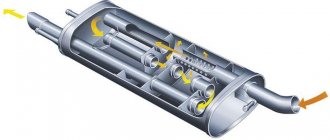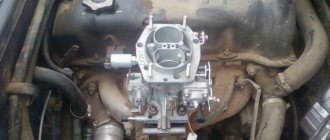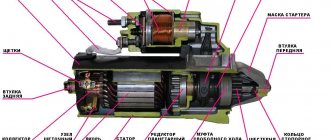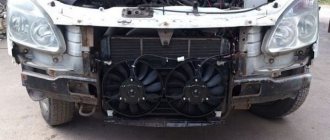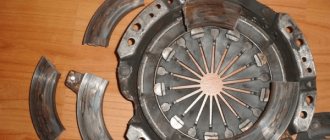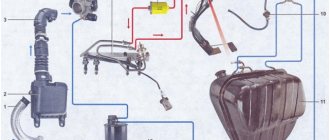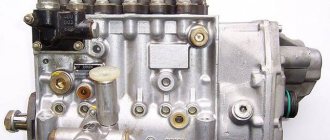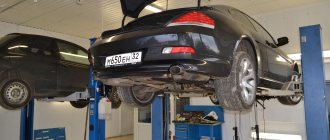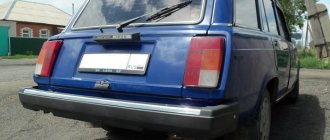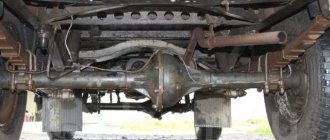Installation of calipers, repair, bleeding
The caliper is an important mechanism in the braking system. Structurally, it has grooves into which the working cylinders are installed. During braking, the pads are pressed and compressed by spring mechanisms against the calipers. The tight fit of the piston to the inside of the structure prevents liquid leakage.
The calipers are secured to the hub with two bolts. To prevent unscrewing, they are covered with a plate.
If a leak is detected in the brake system of the VAZ-2107, it is necessary to eliminate the malfunction. To do this, remove the brake pads. And the system is pumped, ensuring tightness in advance. For pumping you need two people. One presses the pedal, causing the fluid to move. The other one disconnects the connectors.
During repairs, the hose is disconnected and the plate is bent with a tool. Then use a socket wrench to unscrew the bottom bolt. The locking plate will be removed along with the bolt. The caliper can be removed after unscrewing the top bolt. If brake fluid leaks, the working cylinder must be replaced.
labavto.com
If the brakes do not work well, then while driving the risk of an emergency on the road increases, as a result of which all road users, as well as the driver and passengers, are exposed to danger. Therefore, it is necessary to ensure that the brake system (TS) functions flawlessly and to bleed it after repair and maintenance work to replace the working fluid or if air pockets form in it.
Reasons for performing the brake bleeding procedure
Bleeding is performed to remove air from the vehicle. This procedure is necessary after replacing the brake fluid (BF) during routine maintenance work or if it has changed color. Typically, on a VAZ 2107, a complete replacement of the TZ is done after three years. The procedure consists of stages: draining the old fluid, filling in new fluid and bleeding the brake system.
For the VAZ 2107, the manufacturer recommends using TJ DOT-4, its volume is 0.382 liters. It is recommended to add the same liquid that was previously filled. The TJ must meet the manufacturer's recommendations. It contains special additives that protect metal parts from corrosion. Over time, the liquid loses its properties; foreign particles enter it, which have a destructive effect on the elements of the system. These are several reasons why the TJ needs to be replaced. After which it is necessary to bleed the system.
In addition, pumping is mandatory:
- if parts were replaced or dismantled;
- after tuning;
- if the brake hoses are worn out, the vehicle is depressurized;
- The fuel fluid level in the tank has dropped below the minimum.
When the hoses are disconnected, air pockets may form in the hydraulic drive. The danger of its presence in a vehicle is that it makes braking unreliable. When the driver presses the brake, the brake pads on the wheel with air pockets in the circuit do not work, and it continues to spin.
You can tell that there is air in the hydraulic drive by the behavior of the brake pedal and the following signs:
- if you press it several times and at first it presses lightly, and then each time it becomes harder;
- the pedal stroke increases;
- the pedal often falls to the floor;
- braking distance increases;
- When braking, the car pulls away from the direction in which it was moving.
Design and principle of operation of the unit
At first glance, the design of the master cylinder seems complex, since it consists of many small parts. A diagram and list of these elements will help you understand the device (the positions in the picture and in the list are the same):
- Die-cast metal housing for 2 working chambers.
- The washer is a retainer for the bypass fitting.
- A discharge fitting connected by a hose to the expansion tank.
- Sealing gasket of the fitting.
- Limit screw washer.
- The screw is a piston movement limiter.
- Return spring.
- Support cup.
- Compensation spring.
- Ring sealing the gap between the piston and the body - 4 pcs.
- Spacer ring.
- Piston servicing the circuit of the rear wheels;
- Intermediate washer.
- A piston operating on 2 circuits of the front wheels.
Since there are 2 chambers in the GTZ housing, each has a separate bypass fitting (item 3) and a limit screw (item 6).
At one end the cylinder body is closed with a metal plug, at the second there is a connecting flange. At the top of each chamber there are channels for connecting system pipes (screwed on threads) and discharging liquid into the expansion tank through fittings and pipes. Sealing collars (item 10) are installed in the piston grooves.
The GTZ operating algorithm looks like this:
- Initially, return springs hold the pistons near the front walls of the chambers. Moreover, the spacer rings rest against the limiting screws, the liquid from the tank fills the chambers through open channels.
- The driver presses the brake pedal and selects free play (3-6 mm), the pusher moves the first piston, the cuff closes the channel of the expansion tank.
- The working stroke begins - the front piston squeezes the liquid into the tubes and forces the second piston to move. The fluid pressure in all pipes increases equally, and the brake pads of the front and rear wheels are activated simultaneously.
When the driver releases the pedal, the springs return the pistons to their original position. If the pressure in the system rises above normal, some of the liquid will flow through the channels into the tank.
An increase in pressure to a critical level often occurs due to boiling of the liquid. While on a trip, an acquaintance of mine added counterfeit DOT 4 to the expansion tank of the “Seven”, which subsequently boiled. The result is partial brake failure and urgent repairs.
Video: illustration of the operation of the main hydraulic cylinder
Design of the main brake cylinder VAZ-2107
In the design of the system, the brake cylinder is the central element. In his work, he uses the property of brake fluid not to compress due to external forces.
The design includes:
- two pistons (outwardly reminiscent of thimbles);
- sealing rubber cuffs (to ensure tightness);
- two return springs (high stiffness).
Through the holes in the structure, connections are made with fittings to tubes going to the front and rear calipers.
Braking system VAZ 2107. Description
“Seven” has two brake systems: service and parking. The first is designed to reduce the speed of movement and stop, the second is to hold the car while parking (stopping).
The peculiarity of the VAZ 2107 brake system is simplicity and reliability. Complex electronic components (anti-lock braking system, stabilization and brake force redistribution systems are absent), which simplifies independent repair and maintenance of the brake system.
The VAZ 2107 brake system diagram consists of two elements:
- A brake mechanism that directly implements the braking function.
- Brake actuator that controls the brake mechanism.
The VAZ 2107 uses compression disk (front) and expansion drum (rear) brake mechanisms based on friction force.
The hydraulic drive of the VAZ 2107 brake mechanism is based on the transmission of force from the brake pedal to the brake mechanisms through brake fluid. Drive includes:
- The brake pedal controls the brake system.
- Vacuum booster that creates additional force when pressing the pedal.
- The master brake cylinder provides brake fluid pressure in the system.
- Expansion tank for brake fluid.
- Working cylinders that transmit force to the brake mechanisms.
- Fluid pressure regulator in the rear brake circuit, changing the force in accordance with the vehicle load.
- Hoses and lines that carry brake fluid throughout the system.
To increase the reliability of the system, it includes two independent brake drive circuits - rear and front. If one circuit breaks down, the other can perform its functions.
Design of the VAZ classic brake system
The brake system of a car, according to its purpose and functions, is divided into working, spare and parking
The service brake system ensures that the vehicle speed is regulated and stopped with the required efficiency, the spare brake system ensures that the vehicle is stopped with the required efficiency if the service brake system fails, and the parking system serves to hold a stationary vehicle. It can also be used as an emergency brake when the working or spare brake systems fail.
Brake pads, front and rear
In the VAZ-2107 brake system, the front pads wear out much faster than those on the rear wheels. They cannot be repaired. They are replaced with new pads.
The front pads are structurally presented in the form of a metal plate. They rarely wear out due to the asbestos coating that is applied to the surface of the plate.
The rear pads are two rigidly fastened concave plates, semicircular in shape. On the inside they are attached to the hub and tightened with springs. The system is connected to the parking drive spacer lever.
Where is the front caliper of the VAZ 2107
On the “seven”, disc brakes are installed only on the front wheels. The rear ones use a drum brake mechanism. Therefore, in the phrase “front caliper VAZ 2107” the word “front” is redundant. There are only two calipers and both of them are on the front wheels.
Access to the brake calipers opens after dismantling the front wheels of the car.
- screwdriver or bit;
- keys for 17, 14 and 10;
- pliers;
- a piece of rubber tube or bolt with a diameter suitable for the inner diameter of the brake hose tip;
- marker.
It is necessary to remove and install the caliper when replacing it in case of deformation or damage. This is also a necessary action in order to repair the VAZ 2107 caliper.
To carry out the work, you must lift the car on a lift or use a jack. The latter option is somewhat more tedious, but ideal for home use.
Cost of brake pads for VAZ 2107
The price of high-quality pads for a classic VAZ, of course, depends on the lining materials used, technological features and manufacturer.
| Front pads for VAZ 2107 | |||||
| Brand | TIIR (original) | Allied Nippon | AND THOSE | Ferodo | Finwhale |
| vendor code | 2101-3501090 | ADB 0281 | 13.0460-2966.2 | FDB 96 | V 211 |
| Price | 260 rub. | 340 rub. | 700 rub. | 430 rub. | 370 rub. |
| Rear pads for VAZ 2107 | |||
| Brand | VAZ (original) | TSN | ATE |
| vendor code | 2101-3502090 | TSN 2.3.1 | 03.0137-0232.2 |
| Price | 750 rub. | 500 rub. | 1240 rub. |
It should also be emphasized that there are now a lot of fake brake pads for such a popular car. Therefore, choose only trusted manufacturers and pay attention to the packaging, configuration and labeling on the products. For example, the Ferodo brand uses tape with red or blue stripes to seal a box of pads.
Installing the brake caliper
Installation of the brake caliper on the VAZ 2107 is carried out in the reverse order of its dismantling.
After installing the brake caliper, it is imperative to bleed the brake system, removing air from it. Until this operation is completed, operating the vehicle is strictly prohibited.
The left and right wheel calipers are slightly different, so you need to pay attention to this when purchasing new ones. After repairing and installing the VAZ 2107 brake caliper, it is necessary to check the brake system for fluid leaks and, if necessary, repair them
After repairing and installing the VAZ 2107 brake caliper, it is necessary to check the brake system for fluid leaks and, if necessary, repair them.
Brake system maintenance
Although the design of the brakes on a VAZ car is not so complicated, it still requires periodic maintenance, which includes:
- checking the brake fluid level in the reservoir;
- checking the wear of brake pads, drums, discs;
- bleeding the emergency air removal system;
- checking the parking brake cable;
- adjusting the pressure regulator;
- adjusting the tension of drive cables.
Remember that before each trip you should check the fluid level in the tank. Insufficient brake fluid can lead to ineffective operation of the entire braking system. It is worth noting that a decrease in the brake fluid level can be caused by damage to the pipeline and the appearance of a leak.
This type of brake system check should be performed every two to three months. If severe wear or some other problem is detected, it is imperative to replace the worn part or make repairs. Remember that the safety of all road users depends on the technical condition of the braking system.
Absolute vehicle malfunctions
During operation, the braking functions of the system deteriorate. This is due to wear and tear of components, assemblies and parts that require repair. Some vehicle malfunctions are included in a special “List...”, and driving with them is prohibited.
Inefficiency of the working vehicle
The most common malfunction of the brake system (including the VAZ-2107) is inefficiency, which is diagnosed by two main parameters (when carrying out a specialized instrumental study):
- increasing braking distance;
- increase in steady deceleration during braking.
Such faults can be determined by eye.
After driving a passenger car on a dry road at a speed of 40 km/h, when braking, the car travels a distance exceeding 12.2 m. In this case, according to paragraph 2.3.1 of the traffic rules, the use of the vehicle is prohibited (even to the parking or repair site) . This malfunction may be due to:
- presence of air in the system;
- fluid leakage from the system;
- worn out pads;
- failure of the main or wheel cylinders.
In other words, almost the entire vehicle should be subject to monitoring. Repair (replacement) of components and assemblies will require bleeding the system to remove air from it.
Leakage of the working vehicle
During vehicle operation, components, assemblies and parts are subject to wear, which leads to depressurization of the system and leakage of brake fluid. This most often occurs in brake hoses or wheel cylinders. Fault repair is carried out by monitoring leaks and replacing damaged elements.
Leakage of the system also excludes the possibility of operating the car (according to paragraph 2.3.1 of the traffic rules).
Ineffective parking vehicle
This defect is the most common when the car moves involuntarily even with the handbrake locked. This is due to wear on the pads, discs or drums, as well as stretching of the cable elements.
According to the requirements of the “List...”, a parked vehicle must ensure that the passenger car is stationary:
- on a slope of up to 16% at full load;
- on a 23% slope when equipped.
In the event that these requirements are not met, the vehicle can only be driven to a parking or repair site. Repair of the malfunction is ensured by adjusting the cable tension with a special nut or replacing worn parts.
General structure of the vehicle
The diagram of the brake system of the VAZ 2107 car consists of two main components - the drive mechanism and the brake actuators. Due to the drive mechanism, a braking signal is sent to the actuators, thereby bringing the vehicle to a complete stop or reducing the speed.
Braking is performed by increasing the friction energy of friction units with rotating parts. The brake system of the VAZ 2107 is designed in the traditional version:
- The front part is implemented through the use of disc brakes, which are considered one of the most reliable.
- The rear part is equipped with drum devices, the operation of which is also based on friction force.
The brake system drive can be of different types, but the seven uses exclusively a hydraulic type. The hydraulic drive system uses fluid, which acts as the basis of the VAZ 2107 brake system. Brake fluid has the necessary characteristics and is used as a conductor to transmit force from the brake pedal to the actuators - the pads.
To have an idea of what the brake system on the VAZ 2107 consists of, let’s look at the component parts:
- The brake pedal is a driving mechanism that is controlled by the driver.
- A vacuum type booster is a special mechanism that generates an auxiliary (increasing) force when pressing the brake pedal.
- The master brake cylinder or GTZ is a device through which pressure is distributed and increased in the system lines. Due to the increase in pressure, force is transferred to the executive bodies.
- The expansion tank is a sealed container filled with liquid. The volume of the tank is 0.55 liters and the same amount is contained in the system itself, so with a complete replacement the amount of brake fluid in the system is 1 liter.
- Working cylinders are located on each wheel. The design of the front and rear working cylinders is different, but the operating principle is identical.
Relative vehicle malfunctions
This list of faults does not apply to absolute (or categorical) faults. Their presence is associated with the convenience (or inconvenience) of driving.
Increased hydraulic pedal travel (as an option - a “soft” pedal)
The reasons for the “sinking” of the pedal are determined by the presence of air in the system; extreme wear of brake pads; failure of the main or wheel cylinders. The action plan for eliminating technical problems includes checking and repairing all components and assemblies of the system; and, if necessary, replacing failed ones and bleeding the system.
Shift towards the vehicle's trajectory when braking
The malfunction is due to either a failure of the working (wheel) cylinder or wear of the pads. Replacing them (or repairing them) will solve the problem.
Increased background noise, friction (grinding) in the brake mechanism
Deficiencies are localized mainly in the rear mechanisms and are determined by contamination of the mechanism, critical wear of the pads, breakage of spring elements, uneven wear of discs or drums. Fault repair involves washing and replacing mechanism parts.
Vibration when braking
This is a fairly common malfunction that is associated solely with critical or uneven wear of the discs or drums, and the repair will consist of replacing them.
The principle of operation of the brake system in a VAZ-2107 car
When a driver wants to slow down his car, he presses the brake pedal. At this moment, its force is transmitted to a valve in the hydraulic booster, which opens a channel for supplying atmospheric pressure to one of the chambers. In this case, the emerging pressure begins to put pressure on the membrane, which is connected to a rod connected to the piston of the master brake cylinder. As a result, under the pressure of the membrane, the cylinder rod begins to squeeze brake fluid into the pipelines that lead directly to the wheel brake mechanisms. Since the fluid is not compressed at all, all the force is transferred directly to the brake mechanisms. The fluid presses on the internal pistons of the working brake cylinders, they extend and act on the brake pads (in brake drums the pads are unclenched, and in disc mechanisms they are pressed directly against the discs). Due to the friction of the brake pads on the drums and discs, the rotation of the car's wheels slows down.
Vacuum brake booster
This device helps to brake, that is, it is easier for the driver to press the brake pedal. To understand this, just compare how hard you need to press the brake pedal all the way with the engine running and off. When is it easier to press? Correct when the motor is running. How does this work? – To understand the process, we will consider the design and principle of operation of the vacuum amplifier in the following articles, so as not to stretch this lesson to infinity.
Brake mechanism of the rear axle of a VAZ-2107 car
The braking system installed on the rear axle of the VAZ-2107 car has a different design. All its working elements are hidden in the brake drum. The rear axle brake working cylinder consists of a housing containing two pistons. When brake fluid acts on the cylinder, the pistons begin to move out in different directions.
The rear brake pads are crescent shaped and made of metal. Friction plates are glued to the upper edge. In the hub, two brake pads form an almost solid ring. The brake drum also houses the elements of the parking brake mechanism, which we will talk about later.
Hand (parking) brake
Its name speaks for itself. It is needed to prevent the car from rolling away while parked.
Design
- Handle or pedal inside a car
- Cables with adjusting element
- The lever, which is located in the housing of the rear brake element, is connected by cables to the interior lever
- Pad spacer
How does he work
When you “pull” the handle in the cabin and park the car, the lever inside the drum moves through a cable connection. It is connected to one of the blocks by a movable axis (it can rotate around it). The spacer bar rests on one side against the handbrake lever, and on the other side against the opposite block. The lever has a special shape, which, when it moves, causes the opposite shoe to move towards the brake drum. The block rests against the drum cover, blocking the wheel.
To prevent the car from releasing the parking brake spontaneously, the handle is equipped with a locking system that is activated when it is lifted up. In the case of the foot version - when you press the pedal with your foot. To unlock the handle, you need to press a button on it and you can freely lower it down. In this case, the lever in the drum will return to its original position, releasing the pads, which will close under the action of the return springs.
A visual video of the operating principle of the parking brake and working cylinder on a Zhiguli:
